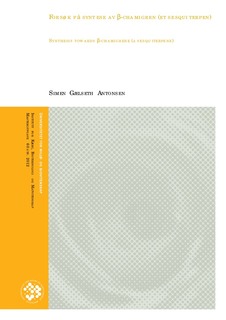| dc.description.abstract | Det ble lagt en strategi for å finne en forenklet syntese av det bisykliske sesquiterpenet, β-chamigren (1). Chamigrener er funnet i en rekke planter, men er først og fremst vanlig i alger, spesielt av slekten Laurencia[1].
Strategien for å syntetisere β-chamigren kan grovt sett deles i to, der den første delen er syntese av det umettede ketonet 3,3-dimetyl-2-metylen-sykloheksanon (25). Denne delen av syntesen er basert på metoder fra en tidligere publisert syntese av β-chamigren[1][2]. Startmaterialet var et billig, kommersielt tilgjengelige keton, 6-metylhept-5-en-2-one. Dette ble reagert med dimetylkarbonat og produktet syklisert til en seksring. Både ketonet og esteren ble redusert med litiumaluminiumhydrid, og det ble satt en beskyttelsesgruppe, tosylat, på primære alkoholen. Sekundæralkoholen ble så oksidert tilbake til keton, tosylat-gruppen fjernet med DBU til det umettede ketonet, 3,3-dimetyl-2-metylen-sykloheksanon.
I den andre delen av strategien ble det umettede ketonet benyttet videre i en hetero-Diels-Alder ved hjelp av mikrobølgeoppvarming. Diels-Alder-produktet skulle så blitt omdannet til et bisyklisk aldehyd som videre kan olefineres. Via Claisen-Cope-omleiring og nok en olefinering skulle dette gitt β-chamigren.
Diels-Alder ble prøvd ut med både metakrylaldehyd, metakrylnitril og etylmetakrylat som dienofil. De to førstnevnte ga dårlige resultater, mens reaksjonen med etylmetakrylat ga et utbytte på 78 % ved 160˚C i 10 minutter (rask oppvarming på 30 sekunders benyttet). Samme reaksjon er gjort tidligere med metylmetakrylat og tradisjonell oppvarming, men da ble utbytte kun på 44 % etter 12timer ved 190˚C[1].
For å gi det bisykliske aldehydet ble etylesteren forsøkt redusert. Det ble prøvd reduksjon med DIBAL uten hell. Det ble da forsøkt å redusere esteren helt til primær alkohol med litiumaliminiumhydrid, men også dette uten hell.
Det ble ikke funnet noen måte å syntetisere aldehydet på, så syntesen var ikke vellykket. På slutten av oppgaven er det nevnt noe videre arbeid som kan utprøves. The goal was to make a strategy to simplify the synthesis β-chamigren (1), a bicyclic sesqiterpen. β-chamigrene has been found in several plants, but most commonly found in algae, especially of the genus Laurencia.
The strategy was divided into two parts: synthesis of unsaturated ketone, 3,3-dimethyl-2-methylene-syklohexanone (25). This first part was based on methods from a previously published β-chamigrene synthesis[1][2]. The starting material was an inexpensive, commercially available ketone, 6-methylhept-5-en-2-one. Reacting this with dimetylcarbonate gave the six membered cyclo ketoester in two steps. Both the ketone and the ester were reduced to alcohols with litiumaluminiumhydride. The primary alcohol was tosylated and the secondary oxidized to the ketone. Using DBU to remove α-protons gave 3,3-dimethyl-2-methylene-syklohexanone.
The secondary part of the strategy was using this unsaturated ketone in a hetero-Diels-Alder using a microwave oven. Converting the Diels-Alder product into a bicyclic aldehyde, that can form an olefin via Wittig or Peterson olefination. Reacting this via a Claisen rearrangement followed by an olefination should result in β-chamigrene.
Both methacrylaldehyde, methacrylonitrile and ethyl methacrylate were used as dienophiles in the Diels-Alder-reaction in order to determine which ones will give the best results. After all: in theory both the ester and the nitrile could be reduced to the aldehyde with DIBAL. The reactions with the aldehyde and the nitrile were not successful. The reaction with the ester on the other hand gave 78 % yield under the reactions conditions of 160˚C for 10 minutes (in addition 30 seconds were used to reach this temperature). A similar reaction without microwave oven gave 44 % yield using methyl methacrylate with the reaction conditions of 12 hours and 190˚C [1].
It was attempted to get the bicyclic aldehyde reducing the ester with DIBAL. This reduction was unsuccessful. Lithium aluminium hydride was used to reduce it all the way to the alcohol, which in theory could be oxidized to the aldehyde. This approach was also unsuccessful.
We did not discover an approach that resulted in the aldehyde. Later in this thesis some alternative approaches will be suggested. | no_NO |
| dc.description.abstract | The goal was to make a strategy to simplify the synthesis β-chamigren (1), a bicyclic sesqiterpen. β- chamigrene has been found in several plants, but most commonly found in algae, especially of the genus Laurencia.
The strategy was divided into two parts: synthesis of unsaturated ketone, 3,3-dimethyl-2-methylene-syklohexanone (25). This first part was based on methods from a previously published β-chamigrene synthesis[1][2]. The starting material was an inexpensive, commercially available ketone, 6-methylhept-5-en-2-one. Reacting this with dimetylcarbonate gave the six membered cyclo ketoester in two steps. Both the ketone and the ester were reduced to alcohols with litiumaluminiumhydride. The primary alcohol was tosylated and the secondary oxidized to the ketone. Using DBU to remove α-protons gave 3,3-dimethyl-2-methylene-syklohexanone.
The secondary part of the strategy was using this unsaturated ketone in a hetero-Diels-Alder using a microwave oven. Converting the Diels-Alder product into a bicyclic aldehyde, that can form an olefin via Wittig or Peterson olefination. Reacting this via a Claisen rearrangement followed by an olefination should result in β-chamigrene.
Both methacrylaldehyde, methacrylonitrile and ethyl methacrylate were used as dienophiles in the Diels-Alder-reaction in order to determine which ones will give the best results. After all: in theory both the ester and the nitrile could be reduced to the aldehyde with DIBAL. The reactions with the aldehyde and the nitrile were not successful. The reaction with the ester on the other hand gave 78 % yield under the reactions conditions of 160˚C for 10 minutes (in addition 30 seconds were used to reach this temperature). A similar reaction without microwave oven gave 44 % yield using methyl methacrylate with the reaction conditions of 12 hours and 190˚C [1].
It was attempted to get the bicyclic aldehyde reducing the ester with DIBAL. This reduction was unsuccessful. Lithium aluminium hydride was used to reduce it all the way to the alcohol, which in theory could be oxidized to the aldehyde. This approach was also unsuccessful.
We did not discover an approach that resulted in the aldehyde. Later in this thesis some alternative approaches will be suggested. | |
